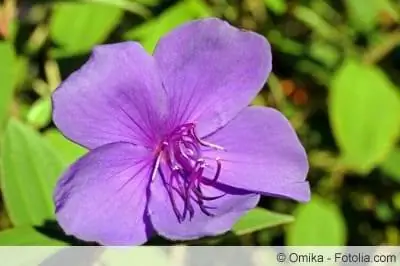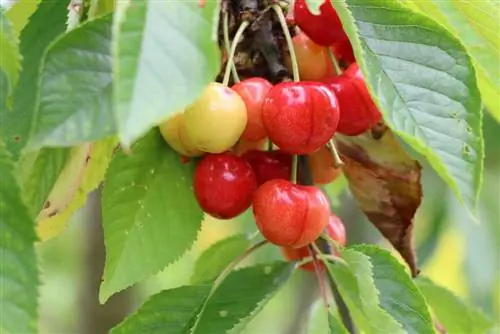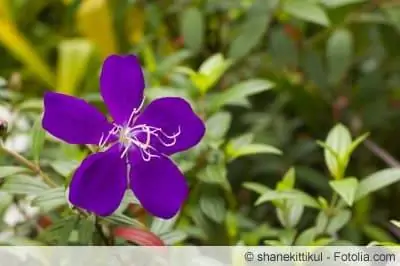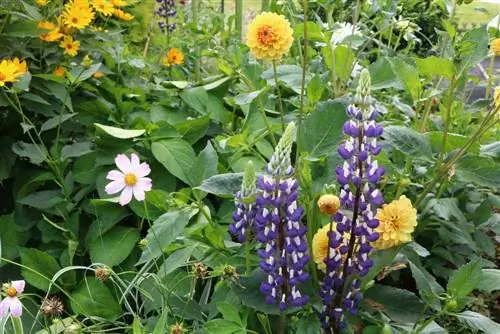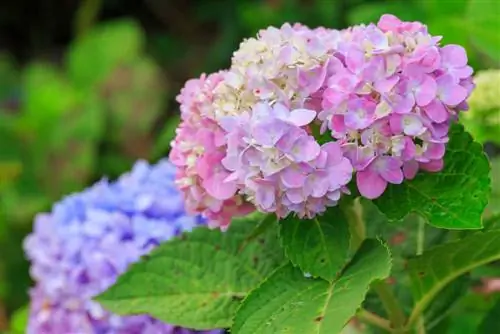- Author admin [email protected].
- Public 2023-12-17 03:39.
- Last modified 2025-01-24 12:45.
Tibouchina urvilleana, which comes from Brazil, is predestined for indoor cultivation in the local regions. The princess flower only reveals its true beauty when it can enjoy the sunshine on the balcony throughout the summer. As a result, shortly before autumn, it spreads its purple and violet cup flowers over velvety leaves, which earned it the name violet tree. You can find out here what requirements the exotic blackmouth plant places on location and care.
Location
A look at the light and temperature conditions in the natural location provides helpful information about where a Tibouchina urvilleana likes it. The flowering shrub is native to the southeast of Brazil with a typical tropical climate with warm temperatures above 18 degrees Celsius all year round, a rainy summer, a dry winter and 12 hours of sunshine daily. The princess flower is therefore well-disposed towards you if it is placed in this position:
- Sunny, warm location
- Protected from drafts and strong winds
- From May to August/September in the sunlight under the open sky
- Alternatively at the south window, which is shaded at lunchtime
Direct UV light has a beneficial effect on compact growth and large flowers. However, if the sunlight is filtered through window panes, the branches stretch out. If the temperatures fall below 10 degrees Celsius, the violet tree leaves its summer spot on the balcony to bloom in the house or heated winter garden.
Tip:
In partial shade and shade, the naturally evergreen princess flower loses its foliage and does not develop flowers.
Substrate
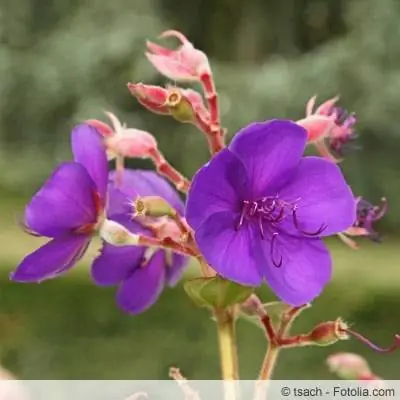
The noble Tibouchina urvilleana requires a structurally stable substrate that is well-drained on the one hand and offers sufficient support for the roots on the other. High-quality potting soil enriched with lava granules and expanded clay should therefore be preferred over inexpensive potting soil. The lower the peat content, the better the substrate meets the requirements of a princess flower.
Watering and fertilizing
The professional care of a Tibouchina urvilleana is based not least on a balanced water and nutrient balance. Extreme fluctuations in one direction or the other are punished by the immediate dropping of flowers and leaves. How to handle it correctly:
- Water thoroughly in summer when the surface of the substrate dries
- Determine daily water requirements using a thumb sample
- Do not leave any water in the saucer to avoid waterlogging
- Ideally water with collected rainwater or decalcified tap water
- Administer liquid fertilizer for flowering plants every 7-10 days from April to November
- A dosage of 2 grams of fertilizer per liter of irrigation water is sufficient
Although the foliage is delicately hairy, plenty of moisture evaporates from the lush biomass in summer. Therefore, make sure that the root ball does not dry out. This means that it is preferable to water less often and thoroughly, rather than often and in small quantities. The irrigation water is applied directly to the root area and not over the leaves. If you don't want to think about fertilizing every week, administer a long-term fertilizer in the form of sticks or cones that are pressed into the substrate. Parallel to each watering session, the nutrients are dissolved in small portions, so that fertilization only needs to be done every 6 to 8 weeks.
Tip:
A coaster filled with pebbles and water not only prevents harmful waterlogging. At the same time, the rising evaporation creates a tropical, humid climate that is beneficial to leaf he alth.
Cutting
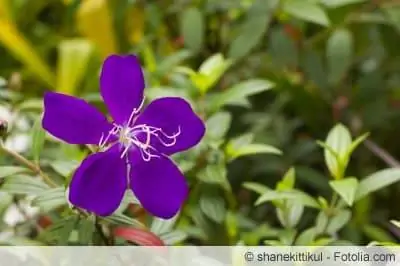
Repeated, careful pruning is one of the main pillars in the professional care of a Tibouchina urvilleana. Since the plant is slow to branch, frequent pruning is essential. If you aim for a rich branching of the violet tree, with as many flowers as possible, proceed as follows:
- Cut back at least 3 times per year: in March, beginning/mid May and middle/end June
- Short the growth of the shoots to half or a third
- Do not cut into the old wood, as new growth rarely occurs here
- In principle, use freshly sharpened, disinfected tools
A young princess bush is initially trimmed after each new pair of leaves in order to form a compact habit. In addition, after flowering, the shoot buds in the leaf axils of the upper shoot continue to thrive. At this point, cut back to the lowest bud, immediately after flowering. The cut is made at a slight angle 3-5 millimeters above the bud, because stumps that are too long weaken the plant and make it susceptible to diseases and pests.
Repotting
A Tibouchina urvilleana is particularly vigorous when young. As a result, within a year it will root through your pot in no time. Moving to a larger container should therefore be part of the care plan in early spring, when this year's budding is about to begin. How to do it correctly:
- The new planter is a maximum of 5-10 cm larger in diameter
- There is an opening in the bottom of the pot for water drainage or is drilled manually
- Drainage made of pottery shards, lava granules, pebbles or pumice prevents waterlogging
- Fill the bucket halfway with the recommended substrate and make a depression in it with your fist
- Unpot the princess flower, place it in the middle of the fresh soil, plant and water
- So that water does not spill over later, a 5 cm pouring edge is left free
If you choose a significantly larger pot, this decision will be at the expense of the flower in the first year after repotting. The violet tree will work diligently to root through the large pot and invests the energy that should actually be used for flowering.
Tip:
Experienced hobby gardeners take a close look at the root ball of a potted Tibouchina urvilleana. The old substrate is completely removed to cut out diseased and rotten roots with a sharp, disinfected knife.
Diseases and pests
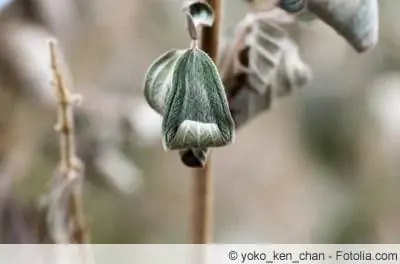
The princess bush is generally considered resistant to diseases and pests. If problems arise, they are usually due to negligence in care. The following he alth disorders can occur:
Spider mites
If the air is too dry during the winter, spider mites appear. The tiny pests initially spread on the undersides of the leaves, recognizable by yellowish-brown speckles and white webs. You can effectively combat leaf suckers with lime-free water. Humidifiers or bowls filled with water placed nearby make the environment so uncomfortable for spider mites that the pests retreat.
Yellow leaves
One of the most common damage to a Tibouchina urvilleana is in the form of yellow leaves. This problem can be due to various causes, which can be solved by simple measures. This is how it works:
Cause: too hard water
As a true child of the tropics, the princess flower depends on low-lime or lime-free irrigation water. If hobby gardeners only use hard tap water, chlorosis occurs. The lime binds important iron in the substrate, which is responsible, among other things, for the green color of the leaves. If you switch to collected rainwater or decalcified tap water, the plant will recover.
Cause: Draft
If there is a violet tree on the windowsill or in the immediate vicinity of a window, this area should not be ventilated. Especially in winter there is an unwanted cold draft that shocks the plant so much that the leaves turn yellow.
Barberness
One of the devastating damages to the princess bush is the progressive baldness from the inside out. The quicker you counteract this, the better the chance of rescue. Immediately place the plant in the brightest place on the south window and protect it from cold drafts. In addition, the water supply should be checked, as both a root ball that is too dry or a waterlogged one can trigger aging. Finally, boldly cut back the shoots by half or two thirds.
Conclusion
The exotic Tibouchina urvilleana brings tropical flowers into the house or winter garden in autumn and winter. In order for the princess flower to give its best, it depends on the right location and professional care. The flower beauty should be placed in a sunny and warm place, ideally on a sun-drenched balcony in summer. A balanced water and nutrient balance and pruning three times a year are among the mainstays of care.

